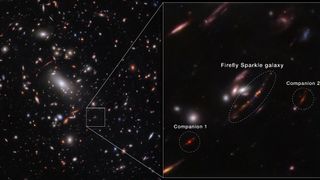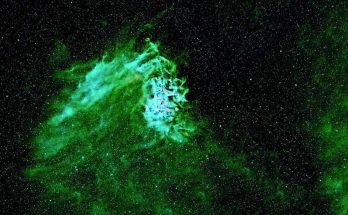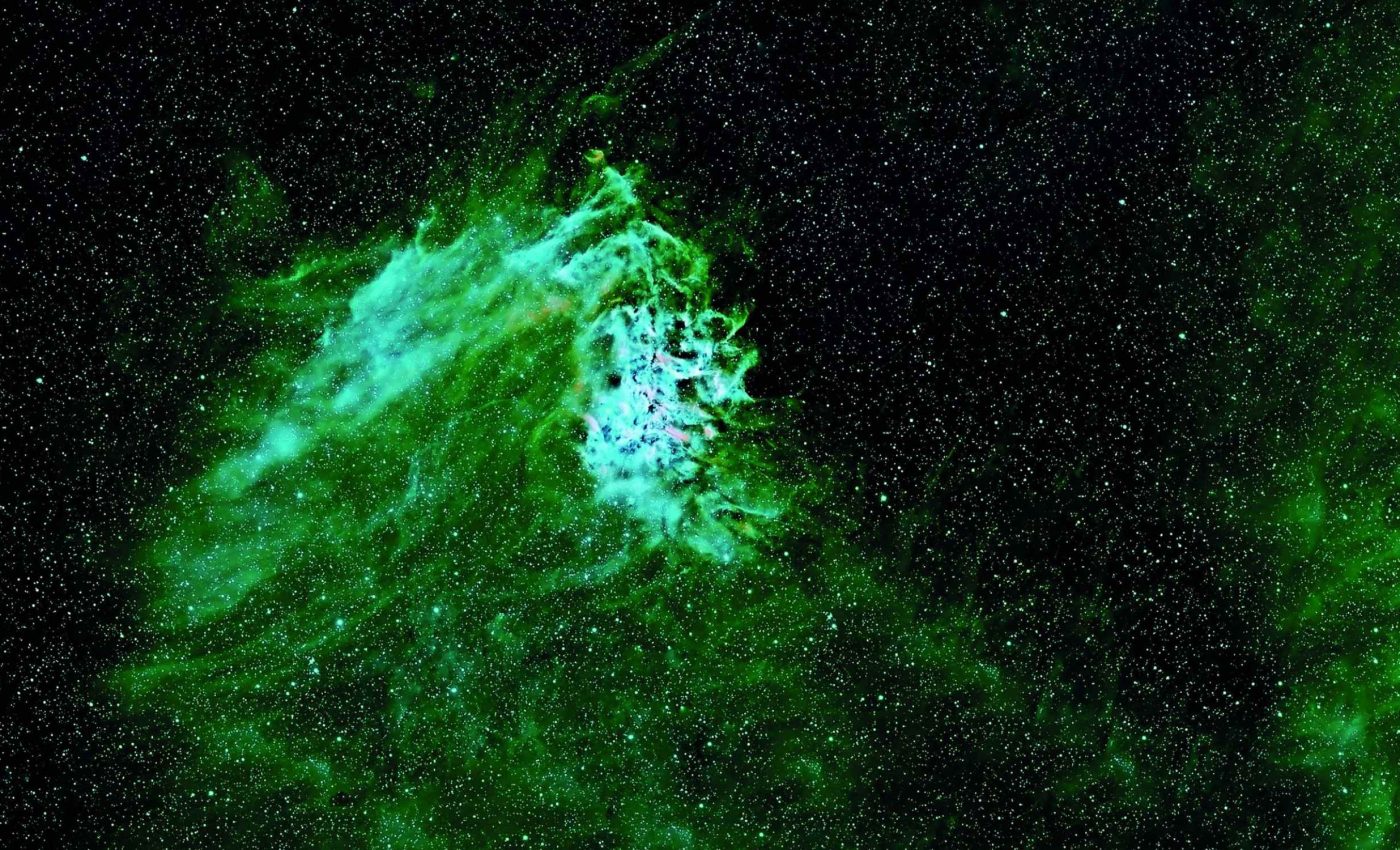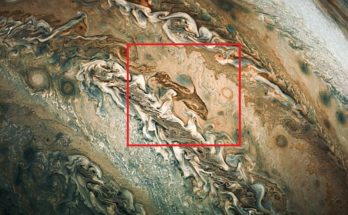Astronomers have identified a remarkable water reservoir hidden in a corner of the cosmos, circling a quasar more than 12 billion light-years away.
At that distance, the light we see today began its journey not too long after the universe itself formed.
The water supply in this distant place is huge, containing the equivalent of about 140 trillion times all the water in Earth’s oceans combined.
This supply is sitting near a supermassive black hole that is about 20 billion times more massive than our sun.
The black hole is surrounded by a quasar named APM 08279+5255, which pumps out as much energy as a thousand trillion suns.
This quasar, according to astronomers, holds the farthest and largest known reservoir of water anywhere in the universe.
Quasar APM 08279+5255 and its water
Matt Bradford, a scientist at NASA’s Jet Propulsion Laboratory in Pasadena, Calif., leads one of the teams involved in the observations.
“The environment around this quasar is very unique in that it’s producing this huge mass of water,” said Matt Bradford. “It’s another demonstration that water is pervasive throughout the universe, even at the very earliest times.”
Both Bradford’s group and a separate team of astronomers studied APM 08279+5255 and its black hole, which sits at the center and draws matter inward.
As it does, it warms the surrounding gas and dust, forming an area filled with molecules that have never before been detected at such an immense distance.
Understanding quasars — the basics
Quasars were first noticed more than half a century ago when telescopes revealed puzzling sources of intense brightness in distant areas of space.
These objects are unlike any ordinary star. They shine brightly from the center of distant galaxies, outshining all their galaxy’s stars combined.
At their heart sit supermassive black holes, millions or billions of times heavier than our sun. As gas and dust spiral in toward one of these black holes, the swirling material heats up and releases energy.
This energy blasts out across all kinds of wavelengths, making quasars some of the brightest, most energetic phenomena ever seen.
Observing quasars helps astronomers understand what the universe looked like long ago, since the light we see now began its journey billions of years in the past.
Quasars can show how galaxies formed, how matter spread out, and how the earliest structures in the cosmos came together.
They can even help map the distribution of matter between galaxies, shining light on the regions that would otherwise remain unseen.
Some quasars also launch huge jets of high-speed particles that stretch across enormous distances. These jets can affect how stars form, influencing entire neighborhoods of cosmic material.
Strange place to find water
Astronomers observed that water vapor is present in this quasar’s environment. It occupies a region spanning hundreds of light-years, with one light-year at around six trillion miles.
Although the gas is thin by Earth standards, it is surprisingly warm and dense compared to what is typical in places like our Milky Way.
The temperature hovers around minus 63 degrees Fahrenheit, and the gas is roughly 300 trillion times less dense than Earth’s atmosphere.
Still, it is about five times hotter and tens to hundreds of times denser than the gas seen in normal galaxies. With its unusual conditions, this region stands out as an unexpected find.
Why does any of this matter?
Water vapor is not just a molecule. Its presence here suggests that the quasar is bathing its environment in radiation that keeps the gas relatively warm.
Astronomers also spotted other molecules, like carbon monoxide, hinting that there is an abundance of raw material that can feed the black hole as it continues to grow.
They estimate that there is enough gas for the black hole to increase in size by about six times, although what actually happens next is not certain.
Some of this gas may form new stars, while some might be thrown out into space instead. Either way, these measurements open a window into what conditions were like when the universe was still young.
Quasars, water, and life’s building blocks
Detecting water vapor in such a distant quasar expands our knowledge of how building blocks appear across vast stretches of time and space.
Water is essential for life as we know it, and its presence billions of years ago suggests that the elements needed for life have been around for a very long time.
Beyond that, water plays a key role in shaping how stars and galaxies evolve. When gas clouds cool, water helps by allowing those clouds to collapse more easily, leading to star birth.
By spotting it this far back, astronomers get new clues about how galaxies changed as the universe aged and matured.
How they found the water quasar
Bradford’s team began collecting data in 2008 with an instrument called Z-Spec at the California Institute of Technology’s Submillimeter Observatory (CSO).
This 33-foot telescope sits near the summit of Mauna Kea in Hawaii. They later confirmed their findings using the Combined Array for Research in Millimeter-Wave Astronomy (CARMA), a set of radio dishes located high in the Inyo Mountains of Southern California.
Meanwhile, another group led by Dariusz Lis, senior research associate in physics at Caltech and deputy director of the Caltech Submillimeter Observatory, used the Plateau de Bure Interferometer in the French Alps.
In 2010, Lis’s team found hints of water in this quasar by detecting a single signature, while Bradford’s team uncovered multiple signals that revealed the massive amount of water present.
Where do we go from here?
To sum it all up, this discovery shows that even at a time when the universe was young, water formed and gathered in places we never would have guessed.
Instead of seeing just cold, empty darkness out there, astronomers have spotted a real treasure — an enormous reservoir of water swirling around a quasar more than 12 billion light-years away.
This water vapor, along with the intense radiation from the black hole at the quasar’s center, paints a picture of an environment that is far denser, warmer, and more active than ordinary parts of the cosmos.
By studying this distant quasar, scientists can learn how the earliest galaxies came together and evolved. They can see how matter spread out, how black holes grew, and how even tiny molecules like water played a role in shaping the universe.
Every new detail uncovered by these long-ago signals traveling through time and space helps make sense of the vast cosmic story we are all a part of.
Other authors on the Bradford paper, “The water vapor spectrum of APM 08279+5255,” include Hien Nguyen, Jamie Bock, Jonas Zmuidzinas and Bret Naylor of JPL; Alberto Bolatto of the University of Maryland, College Park; Phillip Maloney, Jason Glenn and Julia Kamenetzky of the University of Colorado, Boulder; James Aguirre, Roxana Lupu and Kimberly Scott of the University of Pennsylvania, Philadelphia; Hideo Matsuhara of the Institute of Space and Astronautical Science in Japan; and Eric Murphy of the Carnegie Institute of Science, Pasadena.
Funding for Z-Spec was provided by the National Science Foundation, NASA, the Research Corporation and the partner institutions.























